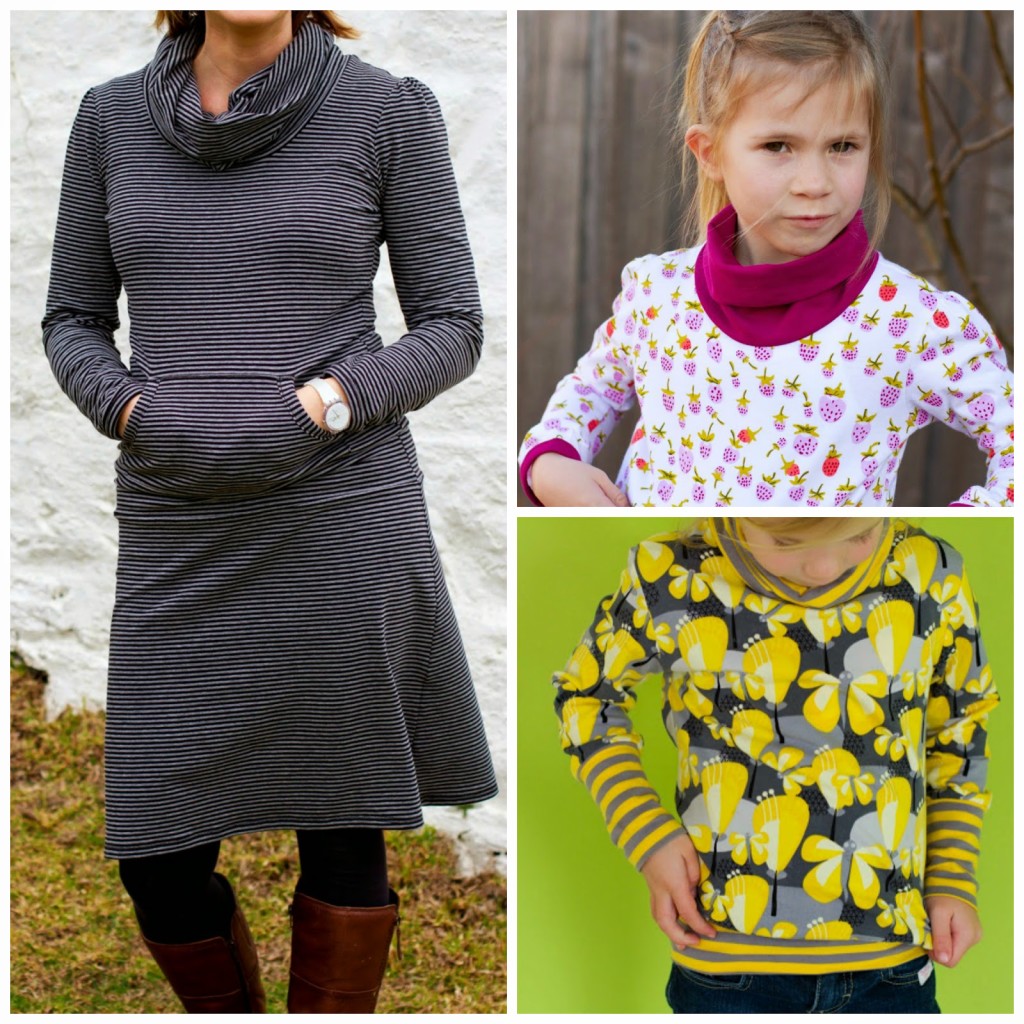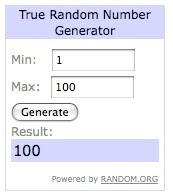I feel like I need to dedicate a post to my love of knit (stretchy) fabrics. It’s kind of funny, because when I first started getting into sewing clothing I was not a fan of knits at all. It was all quilting cotton, all the time. While I do still love quilting cotton and all that it has to offer, there is only so much that you can do with it when it comes to sewing clothing.
I often get emails from people wanting to know where to buy good quality knits from and asking for tips and tricks when sewing knit fabrics so I’m sure there are many other people who wonder but don’t actually ask! Hopefully this post will be helpful for newbie knit sewers and also for those of you who have more confidence with sewing with knits.
 |
| (cowl dress / coastal breeze / mr penguin / hero vest) |
I would have to say that more than 50% of my garment sewing is done using knit fabrics now. Once I got over my initial fear of handling knits, knowing what stitches to use on my machines and working out some great places to buy fabrics from I was hooked! If you look in your wardrobe or at your kids clothes, I can pretty much guarantee that most of the clothing that we all wear is made from knit (stretchy) fabrics so it only makes sense that you gain confidence with sewing with knits in order to make clothes that are practical, comfortable and suitable for everyday wear. When you delve into the world of knit sewing you are opening yourself to a huge range of “everyday” clothes from comfortable tshirts to stretchy skirts and dresses to leggings. Because knit fabrics are stretchy, you very rarely have to use zippers, buttons or other closures to get them over your body! And if that’s not enough to entice you…clothing sewn with knit fabrics need hardly any ironing at all (yay!!!)
When I first started sewing with knits I was pretty clueless. My first few projects were a bit wonky but I learned a lot from them! Now that I have had a bit of practise I love sewing with knits, they are really simple and get worn so much. I have done a lot of research, shopping around and through lots of trial and error here’s a summary of what I know about buying and sewing with knits…
WHAT TO BUY
First of all, I want to talk a bit about the quality of knit fabrics…I don’t know about you, but I’m not in the sewing game to save money! (Does anyone actually save money by sewing? Maybe if you are buying fabric from the op-shop!) but really, this hobby can churn through the dollars if you aren’t careful! For me, sewing clothing isn’t about saving time or money, but is about creating unique items that are exactly how I want them. If I want cheap clothes then I’ll go to Target for some instant satisfaction! Personally I don’t see the point in spending so much time sewing clothes using poor-quality fabrics. I want my handmade clothing to last and still look good wash after wash and using good quality fabrics is the only way to do that. Having said that, you can sometimes get lucky and pick up good-quality fabrics at a decent price.
Also, be aware that good quality knits are more expensive than most woven fabrics. But remember that they are always extra wide (150cm +) so take that into account when comparing with fabric that is only 100cm wide. Out of 1m of knit fabric I can make a top for myself or a couple of tops for the kids so it really isn’t that expensive when you think about it.
 |
| (skippy / joey / basic tees: spy top) |
If you are first starting out with knits then I’d suggest sticking with a cotton jersey or interlock fabric. I’m personally not a fan of interlock fabric because it tends to stretch out of shape after awhile, but I’m happy to use it when the hems of the garment (sleeve cuffs, hem, neckband, etc.) are out of a contrast fabric which is going to hold it in shape. Interlock is really easy to sew with because the cut edges of the fabric don’t roll up. Cotton jersey knits with about 5% elastine or lycra are my favourite knits to work with. Once you feel confident sewing with knits then you might want to test out some other fabric types – and there are heaps more to try!
I know I harp on about good quality fabric all the time…by “good” I mean they wash and wear well – don’t
pill or fade, are a decent weight (thickness), and have a good recovery. (Recovery is the amount of bounce-back you get when you stretch your fabric and then
let it go.) If you sew with dodgy quality knits then you are pretty much guaranteed to have a bad experience.
 |
| (skippy / hoddie top / ninja baby) |
WHERE TO BUY:
This information is mostly applicable to Australian
sewers. We just don’t have the range of shops and fabric choices as are
avaliable in the US so it can be a bit tricky trying to work out where
to buy knits from to get the best quality at the best price. I manage to
source some great knit fabrics though and want to share my secrets with
you here!
Where I live in Tasmania there are no brick and mortar stores to purchase knit fabrics so I have to rely solely on online shopping. This can be a bit tricky when shopping for knits as you really need to see and feel fabrics to know exactly what they are going to be like. After lots of trial and error (yeah, I put in the hard yards shopping – haha!) Here are some of my favourite places to purchase knits online:
CRAFTY MAMAS
My first port of call when I’m looking for new knits is Crafty Mamas. Lisa (CM owner) works like a trojan and is always stocking her store with the most amazing knits. She specialises in European knits and let me warn you now…once you start sewing with European knits nothing else will compare! I was a little spoiled when I first started my knit fabric stash and stocked up on lots of European knits and it has made me extra picky about the quality of other knits that I purchase now! If you want top quality though, you can always rely on European knits to save the day. Look out for brands like Lillestoff, Hilco, ZNOCK, Okeo-Tex and Nosh. Eurpoean knits tend to be pretty trendy and a bit quirky so are great if you are looking for something different. If you see something you like then you better get in quick because new stock is always arriving and once a particular print is gone then it might not be ordered again. Crafty Mamas also stock other great knits too, lots of solids and some Aussie made. I like this shop because they NEVER scrimp on quality I can be sure to get excellent fabric.
DAWANDA
When I am looking for a particular European knit and Crafty Mamas doesn’t have it in stock, then I’ll check out Dawanda. Dawanda is a type of Etsy platform for European sellers. It can be a little tricky to get your head around, because not everything is in English so it takes a bit of guessing or interpreting! This is the only shop that I have ever bought from and I have always been happy with their service – prompt and clear communication. Make sure you set the currency to your country so that you can see what you will be paying and keep in mind that Dawanda stores do not accept direct Paypal paments. You have to purchase Dawanda vouchers (using your Paypal account) and you can then use the vouchers to make purchases from any stores on Dawanda. Also, the price quoted isn’t always the price you will pay – usually I end up paying a little less because Australians don’t have to pay the VAT tax which is included in the price. You actually don’t make any payments until the seller has confirmed the total price for your order and then you can make changes before committing though. Anyway, it’s quite messy and not very straightforward, I don’t use it often but if I’m looking for a particular fabric I will muddle through the system.
FABRIC.COM
This is the only US store that I will purchase knit fabrics from because they have excellent postage rates. To buy knits from anywhere else you are paying around $25 postage for 3-4 yards. Fabric.com is way cheaper than that and have a huge range of knits. Usually I will stick with the designer collections because I can be sure of the quality I am getting…Riley Blake knits are great, as are Robert Kaufman Laguna, Heather Ross jerseys and Liberty of London. (Once I did splurge and buy a couple of yards of this beautiful Liberty of London knit and I don’t think I will cut into it for a long time!) Fabric.com is HUGE and can be quite overwhelming if you aren’t sure what you are looking for. I haven’t delved much into the non-designer knits yet because there are just too many to sort through and I don’t want to risk getting stuck with a dud but I might test out a few in the future!
 |
| (horray! / hero vest / 30-minute skirt / comfy baby) |
IXAT
Ixat is run by an Aussie (I think?) living in South Korea and she manages to get her hands on lots of funky and interesting knits. Shipping takes a long time (4-6 weeks) but they do offer lots of knits that you won’t find anywhere else. Everything I have bought from them is good quality so far, a couple of knits were a bit thinner than I expected but that’s probably because I’m comparing them with European knits. They also have a sister store: IXAT Extra.
OTTOBRE on Etsy
Occasionally I’ll buy European knits from the Ottobre store on Etsy. These fabrics are pretty expensive though so I’ll only only buy from them if I am desperate and can’t find what I am after anywhere else.
SPOTLIGHT
Although you can’t purchase fabric online from Spotlight, most
newbie sewers will probably head into their local Spotlight to source
knit fabrics. Personally, I haven’t had much success finding good
quality knit fabrics in these big chain stores. I always check out what
is avaliable when I go in and don’t usually walk out with anything
stretchy at all. I have bought a few knits from Spotlight that end up
being good but I have also bought a few that aren’t very good quality
and let me down later on. Because of this, I tend to steer away from
buying knits from Spotlight – but with the trend of sewing with knits
picking up, it might not take them long to catch on and start offering
some better quality fabrics. Spotlight doesn’t offer online shopping on
fabrics which is probably a good thing because you really need to see
and feel the fabrics before buying so that you know what the quality is
like.
GIRL CHARLEE
I think I need to mention Girl Charlee here because I have purchased knit fabric from them in the past and I’m sure you see their fabric plastered all over sewing blogs. Personally, I have not been happy with the quality of fabric I have purchased from them and after a couple of orders I stopped buying from them altogether. Everything was thin and flimsy, lots of fabrics ended up pilling and usually the recovery of the fabric was really poor. BUT the fabric is cheap and there is heaps to choose from so that’s why so many people sew with it – remember you get what you pay for though and I’m not keen to shop with them much anymore. I did recently purchase some swimwear fabric from them which seemed okay though but I don’t have much to compare it with yet.
So, those are the main ones that I look at when shopping online – hopefully a new one or two for you to check out. If you have a favourite online store to share then leave a comment for others to see!
 |
| (spy top / summer suits / baby stripes / basic tees) |
HOW TO SEW WITH KNIT FABRIC:
I’m going to give you my top tips for sewing with knit fabric. There are so many posts on so many blogs that share tips for knit sewing success and they all vary slightly. This is really an area where you have to do a bit of figuring out and playing around for yourself to find out what your personal preference is for sewing with knits. And most importantly – get to know your machines! I’ve got a few sewing machines and they all handle knits differently so you really have to test your stitches and machines out first.
KNOW YOUR MACHINES
If you own an overlocker (serger) then use that for all of your inside seams when sewing with knits. An overlocker really speeds things up and makes light work of sewing with knits because you can sew, trim and finish the seams all in one go. BUT…if you don’t have an overlocker then you can still have great success sewing with knits using your sewing machine!
I own a great overlocker now, but my previous overlocker was really old and temperamental and didn’t always do what it was supposed to do. After a lot of frustration, I gave up using it to sew knits with and have had awesome results just using my sewing machine. It took a lot of trial and error to work out which stitches were the best to use on my sewing machine with knit fabric. Before you start on your knit sewing, I would strongly recommend that you read through your sewing machine manual (boring, I know!) to see which stitches are suited for stretch fabrics and testing those stitches on some fabric to see which ones you like the look of and how well they stretch with the fabric when it is pulled.
After you have discovered what your machine is capable of, then make a simple tshirt to test some stitches out on. If you have a child to sew for, then make the tshirt for them (you could try my Basic Tees pattern) as kids really put their clothes to the test with lots of stretching seams and hems! Make sure that the tshirt is worn and washed a lot so that you can see how the stitches last over time.
 |
| (joey / joey / skippy) |
Every machine is different and what works well for someone else may not work for you. For example, I know that lots of people love using a double needle to hem their knits but my double needle stitching always seems to pop and break after a few wears so I never use it any more. But it might work for you, so if you like the look of it, then try it out! And don’t despair, if it doesn’t work for you, there are lots of options you can try!
WHAT STITCHES CAN I USE?
Here are some of the most popular stitches suitable for stretch sewing using your sewing machine and their pros and cons (refer to Figure 1. for an example of each stitch):
MY TOP PICKS
These are my favourite stitches when sewing with knits on my sewing machine:
- I use a stretch tricot stitch for all of my seams that will not be visible from the outside of the garment.
- For most of my topstitching that will be seen from the outside of the garment, I use a triple straight stitch on my sewing machine. I like to use this stitch when I’m sewing binding down from the front of the garment too.
- I love using the mock cover hem stitch when hemming garments.
- If there is ever any decorative topstitching to be done then I like to use a honeycomb stitch.





